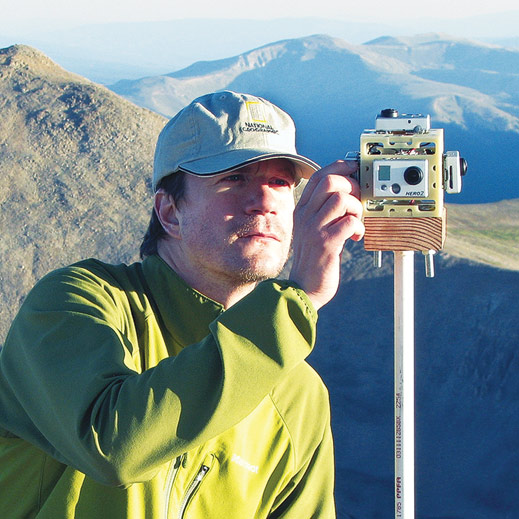Corey Jaskolski has his share of challenging days as a fellow in the National Geographic Explorers group tasked with developing technology to create images of the world’s hardest-to-reach places.

In jungles, he contends with extreme humidity and golf-ball-size mosquitos that land on his lenses. Sand in the Middle East creeps into every mechanical crevice. Affixing suction-cup cameras to 50-foot whales from a 15-foot boat in the open Atlantic is tough. And sometimes when he sends a frighteningly expensive remote camera rig deep into the ocean or launches it into the upper atmosphere, it simply doesn’t come back.
These efforts aim to bring truly extraordinary images to light. “We’re so inundated by images,” Jaskolski says. “What used to be so compelling in photography 30 years ago, these days people look at for only a quarter of a second on a mobile device.”
Nevertheless, Jaskolski has had exceptional experiences shooting King Tut’s tomb, the Titanic wreck, and early human remains in flooded caves.
Jaskolski founded his own firm, Hydro Technologies, in 2002 with his wife, Ann, and fools with cameras and software code at his Denver headquarters, looking for better ways to capture nature. He rigs camera contraptions to suit conditions on the world’s highest mountains or in leagues-deep caves. He also programs cameras to see through foliage and builds modular arrays of cameras for recording 360° scenes, day and night.
After studying math and physics at the University of Wisconsin–Stephens Point, Jaskolski discovered ocean engineering at MIT, where he studied with Professor Chrys Chryssostomidis, SM ’67, NE ’68, PhD ’70, and sharpened his problem-solving skills with Professor Gilbert Strang ’55.
“Whenever I hire folks,” he says, “the question is not what field you’re in but ‘Can you solve a random problem you don’t yet have the tools to solve?’”
Jaskolski faced such a challenge recently: photographing the earliest known human skull, which was discovered at the base of the Hoyo Negro cave in Mexico’s Yucatan in 2011.
“You only get one shot at something like this,” he said after the successful shoot. “You’ve got divers using mixed gases and multiple tanks going thousands of feet into a cave … and you have one chance to get the imagery.”
Jaskolski has several goals left to achieve: planting cameras below the arctic ice, creating a high-resolution digital archive of shipwrecks, and perhaps even finding a megalodon fossil in the depths.
“What’s sitting twenty or thirty thousand feet down there in places we haven’t been?” he asks. “How many new species are down there to discover—ones that will rewrite our understanding of biology?”
Keep Reading
Most Popular
Large language models can do jaw-dropping things. But nobody knows exactly why.
And that's a problem. Figuring it out is one of the biggest scientific puzzles of our time and a crucial step towards controlling more powerful future models.
The problem with plug-in hybrids? Their drivers.
Plug-in hybrids are often sold as a transition to EVs, but new data from Europe shows we’re still underestimating the emissions they produce.
Google DeepMind’s new generative model makes Super Mario–like games from scratch
Genie learns how to control games by watching hours and hours of video. It could help train next-gen robots too.
How scientists traced a mysterious covid case back to six toilets
When wastewater surveillance turns into a hunt for a single infected individual, the ethics get tricky.
Stay connected
Get the latest updates from
MIT Technology Review
Discover special offers, top stories, upcoming events, and more.